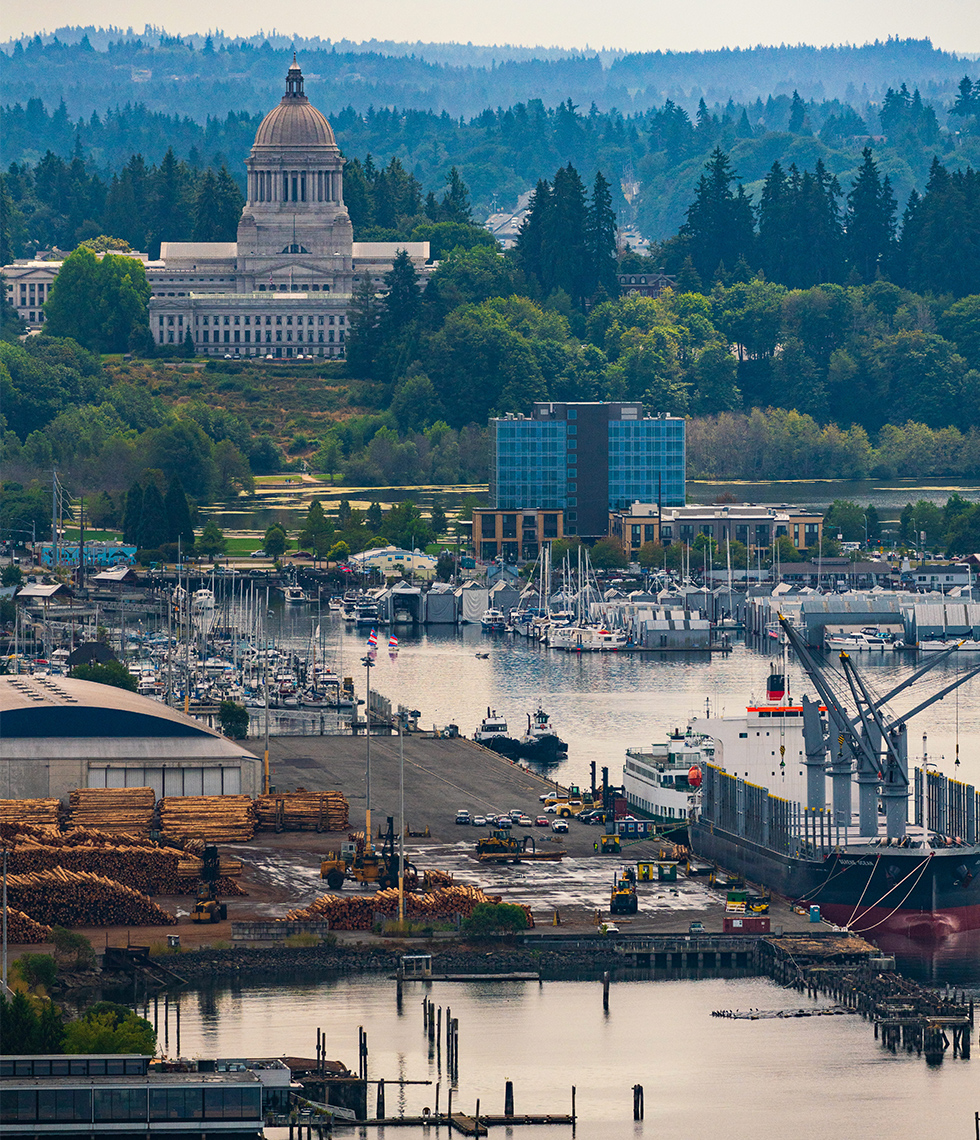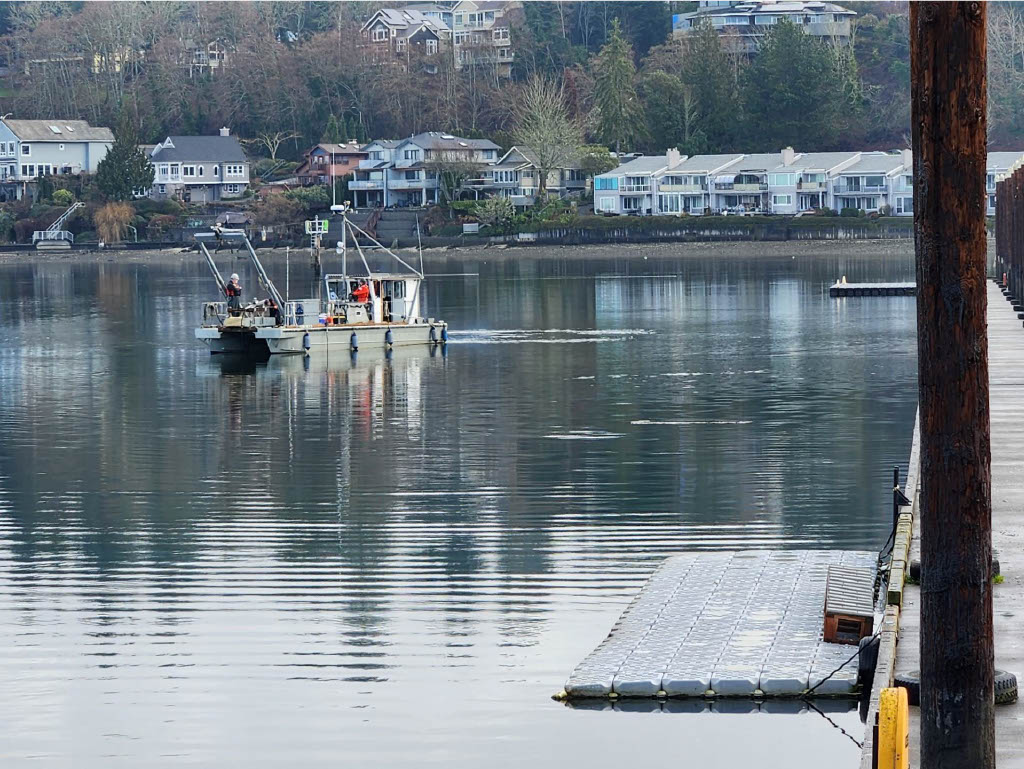Budd Inlet Cleanup and Restoration
Budd Inlet is the southernmost arm of Puget Sound and supports a variety of marine life, including seabirds, marine mammals, fish, and shellfish. The most populated inlet in the South Sound, lower Budd Inlet is surrounded on three sides by the City of Olympia.
Contaminated sediment in Budd Inlet from historical industrial activities dating back to the 1920s presents a negative impact to human health and the ecology of south Puget Sound and impairs maritime operations and recreational boating.
Although the overall risk to human health is low, protecting the health of the community and the aquatic environment is our top priority, making the Budd Inlet Cleanup a key component of the Port Peninsula Integrated Master Plan. We are currently in the investigation phase of the cleanup and working closely with local, state, federal, and tribal partners to create a long-term plan that will:
- Remove contaminated sediment
- Restore habitat
- Dredge Swantown Marina
- Provide more economic opportunities
- Create more public amenities, trails and green spaces
East Bay Sediment Testing Identifies Contamination and Areas for Natural Recovery
More Information
Project Timeline
- 2017-2022: Preliminary investigation
- 2023: Selection of consultants, begin initial design work and public engagement
- 2024-2026: Sediment investigation, data analysis and project design
- 2027: Approximate start of clean-up construction
- 2031: Approximate completion of project
- 2033: Approximate date of 5th Avenue Dam removal
- 2033 onward: Continued monitoring of sediment
Science is Leading the way
The Budd Inlet project team is made up of scientists—a specialized team of engineers, biologists, chemists, and geologists who have extensive experience in marine habitat restoration. Most importantly, the Port is following the Model Toxics Control Act (MTCA), a standardized process set in place and monitored by the Washington Department of Ecology. Only after the State approves of our scientific findings will the Port move to planning and design to discuss future development.
A team of researchers collect sediment samples from Budd Inlet
Other Considerations
External regulations and projects also impact the timing and urgency of the Budd Inlet cleanup plan. We are working closely with the following organizations as they play a critical role in our planning efforts to develop an effective, safe, cost-efficient and environmentally focused plan.
Deschutes Estuary (DES)
The Washington State Department of Enterprise Services owns and manages the Deschutes Estuary, which was turned into a reflection pool for the state capitol in 1951. In 2033, DES is planning to remove the dam and tide gate to improve ecological conditions and restore the estuary back to its original habitat. Since removal of the dam will cause the lake to flow directly into the Budd Inlet, it will have a significant impact on our cleanup and restoration efforts. It is critical that we finalize our cleanup before the dam is removed and water and sediment is released.
The U.S. Army Corps of Engineers (USACE)
The U.S. Army Corps of Engineers (USACE) is responsible for providing safe, reliable, and efficient marine transportation systems (channels, harbors, and waterways) for commerce, national security needs and recreation. Budd Inlet is not naturally deep, so we rely on USACE to maintain the depth of the Budd Inlet through dredging, so that it will remain clear and safe for navigation of commercial and recreational vessels. The Port is working with USACE during the Budd Inlet clean-up process so that they can continue performing routine maintenance.

Building a Healthier Community Together
The Budd Inlet cleanup and restoration aims to not only repair environmental damage but also to address other environmental concerns, such as sea level rise, and to enhance recreational spaces and community connections along the waterfront. The cleanup will benefit the economy, environment, and the greater Thurston County community.
We will make every effort to share project updates with the community on our website and blog and through public presentations. For the latest information, sign up for Budd Inlet email updates, or request a community presentation for your group using the form on this page.
Ask a question or request a public presentation
If your community group or organization would like to learn more about the Budd Inlet Cleanup, we are available for public presentations.
You may also use this form to submit a question or comment for our Environmental Team.
Frequently Asked Questions
About the Project
The contamination is the result of industrial activities dating as far back as the 1920s, before environmental laws and regulations were as protective as today. Previously, there were many polluting industries on South Budd Inlet including wood treating plants, numerous forest products, facilities with burners, and bulk petroleum-storage and handling facilities. The Port has been identified as one of the parties that is potentially responsible for the contamination as they owned the underlying property that was leased to these industries. Other organizations are being identified, though many industries that contributed to contamination no longer operate on the peninsula or even exist. Past and current stormwater runoff and sewage outfalls have also contributed to contamination.
The Budd Inlet cleanup and restoration plan aims to not only repair environmental damage from legacy contamination, but also to enhance recreational spaces and community connections along the waterfront.
Thurston County Health Department advises against swimming and fishing in the Budd Inlet. Contaminated sediment in the Budd Inlet contains dioxins and polycyclic aromatic hydrocarbons (PAHs) that can accumulate in certain aquatic animals such as shellfish, known as “benthic organisms,” that live on or in it. Other animals that eat these organisms can also be harmed, including orcas, salmon, bald eagles and other birds, harbor seals and people. The main way people can be exposed to these contaminants in sediment is by eating fish or shellfish from an area that is contaminated. A top priority of the cleanup project is to protect human health and the aquatic environment and species that live in the Budd Inlet and provide a clean and healthy waterway for our local community and wildlife.
Yes. The Port is part of the Olympia Sea Level Rise Response Plan collaborative which includes the City of Olympia and LOTT. The Sea Level Rise Plan recommends actions that the parties will undertake to mitigate the effects of sea level rise and global warming. The Port will investigate the use of dredge material to raise the level of the Port Peninsula and create landscape berms and raised walkways. Future projects that address sea level rise and increased precipitation also include the development of a flood monitoring strategy, installing an array to monitor land subsidence, and creating Design and Development Standards.
Before the Port begins habitat restoration, we first need to know what habitat needs to be restored. This is determined by testing for contamination, finding out where it is located, and then designing a plan to eliminate that source. When the cleanup of the contamination is complete, we will have more assurance that habitat restoration will succeed. For instance, the Budd Inlet cleanup plan will help identify areas for sediment relocation and habitat creation as well as complete the cleanup actions required by the Washington Department of Ecology. The cleanup plan will also include required mitigation, which may include targeted habitat restoration.
At this time, it doesn’t appear to, but if it does, the Port will be required to complete another round of remediation. With the approval of the Washington Department of Ecology, the Port performed a major cleanup to remove and contain contamination at the Cascade Pole cleanup site in the early 2000s. Approximately 40,000 cubic yards of sediment was dredged from Budd Inlet and placed into an upland containment cell which was capped, surrounded by a wall and safeguarded with a groundwater pump and treat system. The Port continues to monitor the groundwater and if it is found that the remedy is no longer protective, Ecology will require further remedial action.


About the Science
Yes! Port staff overseeing the Budd Inlet Cleanup and Restoration Project are all scientists by training and experience. We are working closely with a consulting team of engineers, biologists, chemists, and geologists that specialize in marine contamination sites. Also, the Port is following the Model Toxics Control Act (MTCA) as required by the Washington Department of Ecology. The MCTA process is rooted in the scientific method and uses a standardized practice to detect and measure contaminants in sediment. Only after Ecology approves of our scientific findings will the Port move to planning and design of future development.
The Port is required under MTCA to utilize the best available protocols to screen and test for DNAPL (e.g., creosote). The Port will collect surface and subsurface core samples and those will be field screened for the presence of DNAPL. If that screening suggests the presence of DNAPL, samples will be submitted to the lab for chemical analysis. So far, none of the samples have revealed DNAPL, but we will continue to look.
Dredge sediment may be used upland for habitat restoration or raising land to protect against sea level rise. The sediment may be amended to add stability. However, this method will only be used with minimally contaminated sediment and with the Washington Department of Ecology’s approval, as protection of human health and the environment is our priority.
No. Legacy contamination in Budd Inlet is not the cause of low levels of dissolved oxygen in Budd Inlet.
Extensive, science-based investigation has been conducted to determine what is causing the low oxygen levels, also known as hypoxia. One cause for low oxygen is when excess nitrogen enters a body of water. Nitrogen can enter the water in a number of ways including yard waste, wastewater, stormwater runoff and other sources that are not easy to identify, such as farms. While nitrogen is naturally present in marine waters and marine life requires nitrogen, too much nitrogen fuels excessive algae growth, resulting in “low dissolved oxygen.” When oxygen is depleted, it can cause stress, and even death, in aquatic organisms.
Capitol Lake has been identified by the Washington Department of Ecology as the largest source of oxygen-depleted water within Budd Inlet. Ecology has also said the most important action needed to reach water quality standards in Budd Inlet is the development and implementation of a long-term management solution for Capitol Lake.
In their report, Ecology also evaluated the Port’s operations, including Swantown Marina & Boatworks and our Marine Terminal, and did not find they were the cause of low levels of dissolved oxygen.
While the Port is not responsible for Capitol Lake, we are committed to the long-term health of Budd Inlet. We are working closely with the Washington State Department of Enterprise Services (DES) to integrate our Budd Inlet cleanup project with the Deschutes Estuary Restoration project.
DES is in the early stages of a project to restore Capitol Lake into a functional estuary, which in turn will help address the low dissolved oxygen in Budd Inlet. The Port is also currently collecting data so that scientists can inform the creation of a plan to clean up the contaminated sediment from historical industrial activities. These two projects combined will have huge and lasting impacts on both sediment and water quality in Budd Inlet.
About the Funding
We are currently in the process of identifying the best way to clean up and restore Budd Inlet, which will determine the cost of the project. We will continue to update the community with more information as the project progresses.
The Port is actively looking to secure funding for the cleanup and restoration work through available grants, state and federal appropriations, and partnerships. Several potential sources of funding have already been identified. In addition, the Port has received two Remedial Grants from Ecology and funding from the legislature to conduct the investigation and studies needed to identify cleanup options.
While the Port of Olympia is actively looking for outside funding sources, the Port does rely on tax levy dollars for some of the environmental cleanup and restoration costs.


